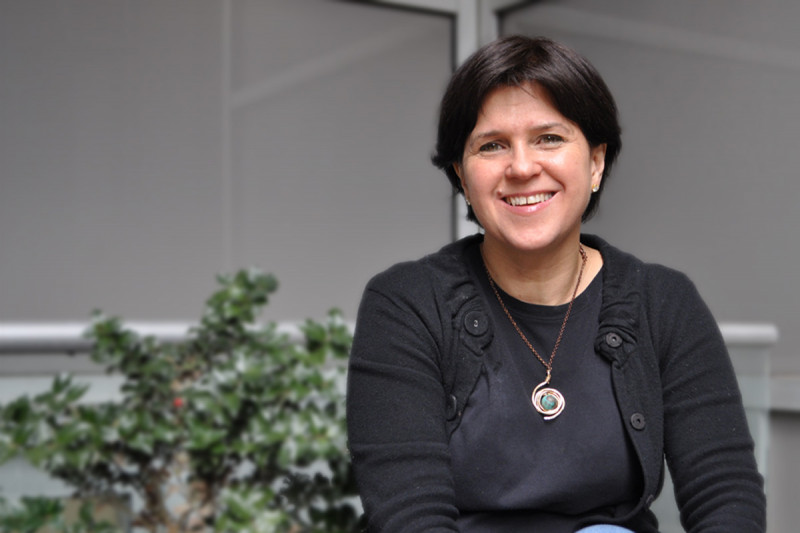
"One of the strengths of SKI is that everyone wants you to think big and be bold," says Mary Baylies.
Mary Baylies is a developmental biologist studying muscle biology at the Sloan Kettering Institute. Her work is clarifying how muscle cells form and are repaired and what goes wrong in muscle disease. We spoke to her in August 2018 about how she got interested in science and what sparked her particular focus on the biology of muscles.
Lucky Seven
I’m the product of a devout Polish Catholic family, the seventh of eight children and the only daughter. On the one hand, my dates had to meet my six older brothers. On the other, my brothers included several engineers and medical personnel. When I was growing up, there were always biology and medical books around the house. I remember sitting up at night when I was supposed to be in bed, leafing through those books. I think I was a science nerd from early on. I just always really loved it.
In high school, I had an amazing biology teacher. He brought so much fun and excitement to class. How could I not want to be a biologist? At that time I thought, I’m going to be a neonatologist using gene therapy — which was very specific. But then when I got to college, I fell in love with molecular biology and with doing research.
When I explain research to people who aren’t scientists, I ask, “Do you know that feeling of staring into the dark night with only the light of your house behind you?” You can’t see much in the distance — it is unknown. But then you turn on a flashlight, and you shine it into the unknown. You reveal what is there and try to understand it. That’s what research is all about. You’re pushing the envelope of what you can see and know. That’s what I found in college, and I never looked back.
Summer Camp for Scientists
I did my PhD across the street at The Rockefeller University. I was working in Mike Young’s lab on biological clocks and circadian rhythms. I asked questions about how an organism makes a biological clock and how that clock works. While I had a lot of initial success in the lab, I did have my setbacks, particularly when I couldn’t get my next big project off the ground.
I decided to do what many graduate students do: I went to “summer camp.” In graduate school that means I took a course at Cold Spring Harbor Laboratory during the summer. It was a class on the neurobiology of the fly brain. I thought that gaining a better understanding of how the fly brain works would help my project. In this course I met the person who would become my future postdoc mentor, Michael Bate. He was at the University of Cambridge in the United Kingdom. He was interested in neural circuitry, like the one that makes up a reflex arc, which is a motor neuron connecting to a muscle and then a sensory neuron connecting back to the motor neuron.
He presented the muscle pattern of the fly embryo in one of his talks. He said, “Here’s the muscle pattern of the embryo. No one knows how this pattern is formed. If we don’t even know how those get there, how can we try to understand the circuit?”
I was enthralled with this problem. I knew it would require being on the edge of what’s known, and I liked that. It would also require using different types of genetic approaches. It involved studying how different cell types interact in living animals. I thought this was a large problem that needed solving. After that, I decided I was going to try to understand muscles.
Learning by Osmosis
When I was recruited to the Sloan Kettering Institute, I learned that we were expected to do the best science that we could. It didn’t matter if you were working on the muscle biology of the fly or something more obviously cancer related. One of the strengths of SKI is that everyone wants you to think big and be bold. You don’t have to connect your work directly to cancer necessarily. However, just by being here, it comes by osmosis — you find the links.
For example, we currently have a project on rhabdomyosarcoma, which is a sarcoma that primarily affects children. This tumor expresses muscle genes like myosin, which helps muscles contract, so it has muscle-like characteristics. I’ve had pediatric oncology fellows from the hospital come to my lab to do rotations. This has given me a window into the relevance of our work to pediatric cancers. That probably wouldn’t happen at other places.
Best Parts of the Day
What’s really exciting to me is when a person in my lab comes to my door and says, “I have something to show you.” As developmental biologists, we’re very visual. It’s usually at the microscope they want to show me something or some image that they have on their computer. And that makes it worth it, all the grant writing and stresses of running a lab. Because they’ve seen something new and — whoa! — we are back with a flashlight shining our light.
Cooking is another of my passions. I like to cook when I get home and on weekends. We have a garden — my husband built me six large raised beds last summer — so I’m always trying to come up with creative ways to use the extra vegetables. I think a lot of scientists are fantastic cooks because we’re used to working with our hands and juggling several sets of instructions at once. It also comes from my heritage. My mom was cooking for us all the time. Who knows, maybe if I hadn’t gone into science I’d be a professional chef. But probably not a mother of eight.




